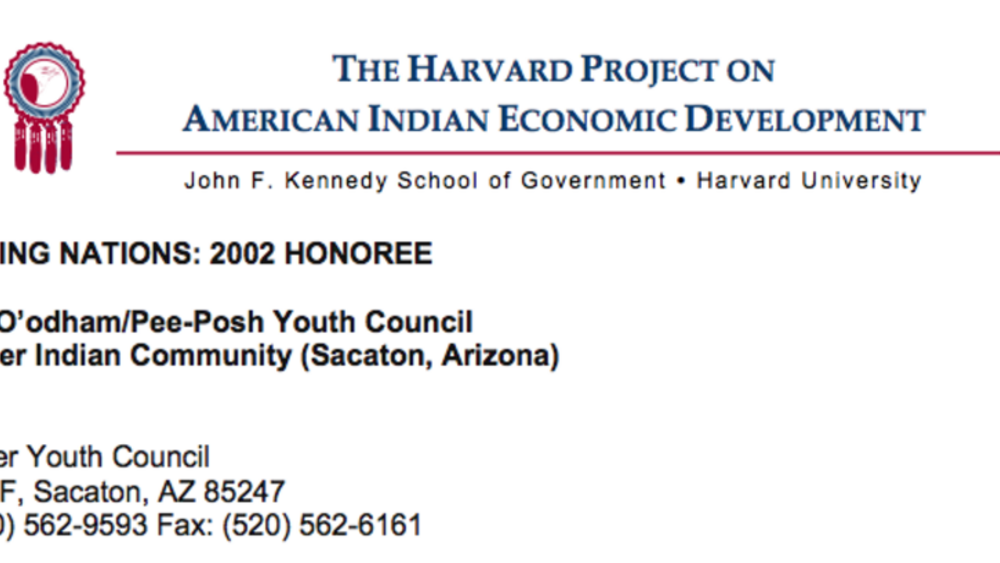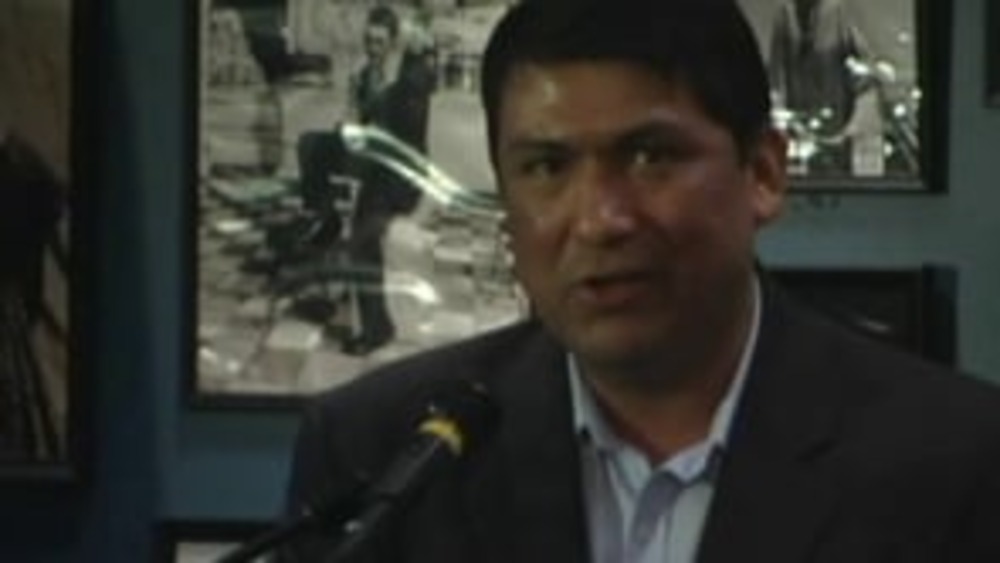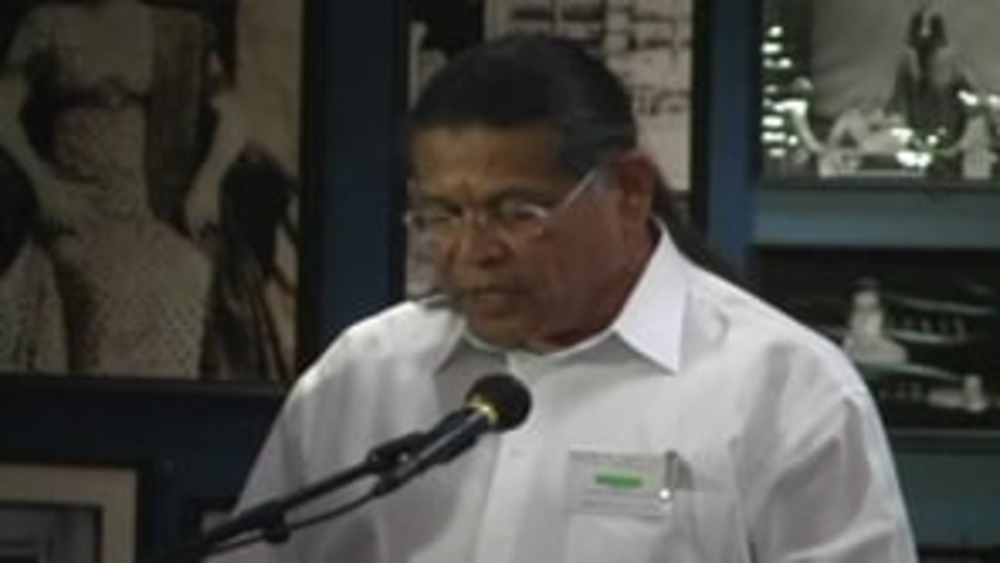Former President Myron Brown discusses how the Akimel O'odham/Pee-Posh Youth Council is an example of building a great program in a political setting, and shares how Gila River youth are having their political voice heard through this innovative leadership development mechanism.
Additional Information
Brown, Myron. "Akimel O'odham/Pee-Posh Youth Council." Honoring Nations symposium. Harvard Project on American Indian Economic Development, John F. Kennedy School of Government, Harvard University. Cambridge, Massachusetts. September 10, 2004. Presentation.
Transcript
"'Building Great Programs in a Political Setting' is what I would like to present to you today. Youth have always have had the disadvantage of being both young and inexperienced in getting both their voice and needs recognized and heard. To engage in this type of dialogue at the tribal level [can be frustrating]. What has developed over the past 16 years is a series of interlocking programs and activities. These have provided the youth with a series of long and hard engagement within the world. This engagement has allowed the youth of Gila River to both understand and appreciate the efforts of working in a political setting. The following is a brief summary of the programs and the activities provided to 'Building Great Programs in a Political Setting,' and this program gives a basis by which to operationalize the following activities for hands-on engagement of active participants in the political setting.
One of our main programs that the Gila River Youth Council hosts every year is the Gila River Close Up Program, which started in 1998. This annual event explores the rights and responsibilities of tribal members' involvement in American and tribal government. The Gila River Close Up is an educational and leadership project for high school community youth to promote participation in government process. Now, with this program we usually...it's an intense two-day gathering within the...we invite, I think, 50 students from the community to participate in this program. And we host it. It's at a hotel; it's a two-day gathering. And that, within those two days the kids learn about our tribal government, the three branches of our government: legislative, judicial, executive. What we recently found out through Andrew Lee is that this is actually, the Close Up Program, Gila River is the very first, the Youth Council is the very first to focus a Close Up program on the tribal government and not on the state government. So that's one good thing, because our children, our kids in the community know a lot about the state government, the federal government and how it works, but they're not too familiar with the tribal government. It's a whole different thing, how our tribal government works. And then so...and during this two-day gathering, we invite a speaker from the state or the federal government. Speakers include Representative Cheryl Chase, Pete Rios, just like our tribal government, like our tribal leaders, people like that, people who influence our community. And within the two-day gathering, they get to travel to the courts and they have a mock trial. And so it's really interesting and the kids get to learn a lot about the community and the government.
Another program that we have is the Gila River Kids Voting Program, which the Gila River Kids Voting Project features specially designed curricular for grades K-12, and culminates with the community youth accompanying parents to the voting place on Tribal Election Day to cast their ballot in simulated election. The purpose is to instill lifelong habits in youth and boost voter turnout among future adults. Now, another thing is since this is a critical time, the Tribal Election is coming, the state election is here, the federal election is here, and so we're getting ready for the general election. And with that the kids get to vote. They get to vote for the president, they get to vote for state representatives, and it's simulated. And so the gig is they have to bring their parents along with them so they can vote, which is a cool thing because the kids want to vote. The kids, 'I want to vote.' And so the thing is they have to bring their parents with them. And our Tribal Election Department credits the kids voting for bringing a seven-percent increase in voter turnout in our community. And with that we have seven tribal schools, and so the youth population in the Gila River Community, the population in the community is almost 20,000, and the youth make up over 50 percent of that. So we're also the first tribe of the nation to have kids voting at a tribal, state and national election level. And so with that, the 2005 election is coming up, and so we're getting ready for that. And that's really a good thing. So we're just getting really ready for this election, the kids are excited. I actually work the voting polls, and this past primary election our state had, kids started coming and showing up. And the kids voting...it's not until the general election that the kids voting starts. And so kids were like, 'Can I vote?' I'm like, 'Aw. Yes, you can vote in the general, but please remember, bring your Mommy and Daddy, you know.' And so that's another influential program that the Youth Council offers.
Another, our next program, as you've seen in the video, a lot of that was with our Gila River Youth Conference. The Gila River Youth Conference is held annually for community youth and draws an average of 500 youth. An intense two-day gathering of addressing the issues rose during the year with regards to input from tribal leaders and recommendation to tribal leaders. During this time, changes to policies and procedures may be raised, new officers may be elected, and the direction of the council may be set for the upcoming year. This activity promotes youth leadership and communication while building confidence and self-esteem. Over this past summer, we just had our, we just celebrated our 16th Annual Youth Conference, and it was at our brand-new Sheraton Wild Horse Pass Resort. And so the focus for this year, we thought it best, we focused on diabetes seeing as though Gila River Indian Community is rated number one in the nation for high diabetes. And so the Youth Council thought, 'Well, let's do our conference on, you know, health,' which was, and we got a great turnout this year. We invited our hospitals, we invited our community leaders, we had a health panel, and the hospital did a, what do you call it, it was like a fair, like a hospital fair, you know, they had the X-ray department, they had the dental department. A lot of the kids who want to be, you know, maybe kids who want to be future dentists or doctors, you know, a lot of kids liked the booths. And so that was really good. There was a really good turnout in the workshops that we had, workshops such as, you know, dealing with health issues. Most of the workshops we had were, had to do with health. And so it ended. And well, we got a good turnout. Some have even called it the best youth conference ever. So I was really excited with the youth conference.
And not only with the youth conference do we talk about future issues, it's also whenever we elect new officers for the Youth Council. And with that, on one of the days we send all the youth to, our community is composed of seven districts, almost like political districts. And so the youth from their respective districts would go into these separate rooms, district one through seven. And then so we'd have the leaders...like I'm District One, so I would lead the room. And since my term will be ending, you know, you'd address the youth, any of the youth who want to participate in the Youth Council, they'd nominate themselves or declare themselves candidates. And so with that they go through a process, they go through a caucus, they go through speeches, and then they go through the vote. And it's the youth of the community that vote them in the office. It's the youth of our community that vote us into office. And so, and then the results come back within the last day. We usually have dances every night for the young people and the results come in the last day, 'So and so, you're declared our District One candidate.' So that's how we develop our Youth Council, is through our youth conferences.
And closing with my presentation, as a result of the Honoring Nations 2002 study, these are the lessons that they concluded with: statements about the importance of tribal youth should be backed by concrete investments in their development. For example, tribal leaders can facilitate the establishment of youth councils, host, fund and participate in youth activities and events, and encourage you to participate in national organizations. These and other investments inspire youth to make a positive difference in the community and build up the pool for future leaders. With appropriate training and organizational support, youth can make meaningful contributions to tribal government, they can offer input into the issues affecting their peers, provide guidance and feedback in policy formation, and serve as effective spokespeople for the tribe. Like tribal governments, tribal youth councils require good organization, by-laws, staggered terms, a code of ethics, election rules, and clear processes for decision-making are institutional ingredients for success. So with that, that is the conclusion of my presentation. I'm open to any questions, you know, later on. So if you guys see me just holler or something."
Amy Besaw Medford:
"Does anybody have any questions right now? I can pass the microphone around."
Audience member:
"Are you open to invitations from anybody like us? We would like you, representatives of the Youth Council to come to our community to visit us."
Myron Brown:
"Can you say that again, please?"
Audience member:
"Are you open to invitations from communities all around the country? Like we would like one or two of your representatives to come and talk to our youth in our schools."
Myron Brown:
"Exactly. We're open to anything like that. Did I hear it right or what? I hope so. I think. I hope I heard what you said. But we get a lot of invitations from different youth around the country, youth who want to form organizations just like our Youth Council. Everywhere we go, you know, we always meet new people, and they're always fascinated by our program and they want to form something like this in their community. And so just get in contact with us. I have a business card if you've like more information about our youth council and how it got started. So, yeah."
Amy Besaw Medford:
"Does anybody have any questions for Chairman Pico or for Professor Mary Jo Bane or Myron Brown?
Audience member:
"I have a question for the speaker. Are things changing? You said traditionally, elders...oh, I'm sorry. I was talking to the Youth Council person. I'm embarrassed. OK, let me start over. I'm sorry. What I was going to ask is are things changing at Gila River? Are the elders now making a place for the youth? I mean it sounds like you've carved out your own."
Myron Brown:
"Yeah."
Audience member:
"But are they now looking to you for answers to some of the pressing issues there?"
Myron Brown:
"Well, we're always involved with our elderly nowadays. I mean we invite them to our youth conferences. This past youth conference, a lot of elderly came. They had so much fun. They danced with, sometimes they will dance with us, we'd have a good time with them. So to answer your question, yeah, we're involved with our elderly now. They have opened up a lot. They have pretty much adapted to our Youth Council, and so we're very thankful and we look up them, and so if that answers your question."
Audience member:
"It's more of a comment than a question. After today's presentation, I began to reflect a little bit about what's happening at Lummi. We have the Lummi Cedar Project, which is a youth initiative. We have a youth leadership program in place where they're looking at starting to serve as voting members on our nine commissions that we have in advisory capacities to the council. And after hearing the presentation today, I can tell you there's a national movement and is not limited to just Indian Country. I wanted to close my comment out with saying that I have every bit of confidence that Indian Country is going to be in good hands."
Myron Brown:
"Thank you."
Amy Besaw Medford:
"One more."
Audience member:
"I also, just to applaud the amazing things you're doing with the new community, and sort of to follow-up on the, I guess the question about the elders is the next question is, is within the tribal governance and leadership, is it the intention to be able to also have a voice there, or do you have a voice?"
Myron Brown:
"We do have a voice there. It's a formal voice. The Tribal Council is always asking us questions. They always want our input, which is a good thing because it never used to happen before 1987. It never was like that. Like Greg [Mendoza] and his friends, it was never like that. That's why we formed the Youth Council. Now that we're formally recognized as a youth council, the Tribal Council now make some kind of recommendations. Like an example, the Cardinals stadium that was coming into our community, it was a big issue for our community. And so the Tribal Council said, 'Well, why don't you guys ask our youth about it, ask our youth how they feel. What do they think about this big thing coming into our community? So the head from the Cardinals actually came to our youth council, made a presentation, and was giving out freebies trying to really, you know, trying to really go for that 'yes' vote. And of course, giving out footballs and all the good stuff. And so, yeah, I mean it's a good thing. The Tribal Council has always...we have a voice there. We also present matters to the Tribal Council. Like at our youth conference, we go into like unity circles and we basically develop problems. It's usually something, since our last conference was about health we talked about issues in health, why is everybody diabetic? Kids post some really good questions, and so at the end of the conference those questions are then tabulated into a report and it goes before Tribal Council. And they get to see what we talk about, and maybe changes can happen from there. So those are just some of the good things that the Tribal Council has done for us. And it's a bonding thing, we're all one."



